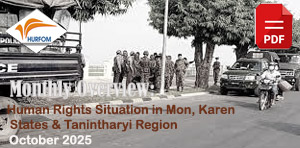SPDC fines villagers for digging bomb-shelters for their security in Kyainnsekyi Township
July 1, 2010
HURFOM, Anan Kwin: Villagers have been digging bomb shelters for protection against the increasingly frequent skirmishes between the Burmese State Peace and Development Council (SPDC) and the Karen National Liberation Army (KNLA) forces. However according to the local SPDC commander the presence of these shelters destabilizes the community and has issued harsh fines and threats of forced portering for families who already have built or will built, shelters to improve their security.

Since the early of this May, villagers in Anan Kwin village, Three Pagoda sub-township, Kyainnseikyi Township, Karen State, had been building homemade bomb shelters, or locally called “cover-holes” (Kar Bar Kyin in Burmese). HURFOM’s field reporter has found that nearly every household at this point has dug a bomb-shelter. However, according to the information from locals, unidentified battalion officers from Tactical Command (TC) No. 2 based in Anan Kwin operating under South East Command (SEC), have ordered villagers to stop building shelters, condemning the presence of bomb shelters as making the region unstable. Villagers who had already dug bomb-shelters tagged with fines of twenty thousand kyat per completed bomb-shelter. Villagers were also threatened that if they continued digging bomb-shelters, besides a fine, they will be severely punished with forced portering.
U Htin, 60, a cultivator of betel and cashew nuts, was not punished with any fines because he did not dig a bomb-shelter, but his son had to go to Anan Kwin military base and pay the fine of twenty thousand kyat because of a bomb shelter in his house’s compound. His son is 28 years old and the father of two children:
For the persons who had already dug bomb shelters, they are fined twenty thousand kyat per hole because of their ‘making the region unstable’ and ‘causing the locals to feel frightened’. Heads of the households had to come to the military base and pay the fine. If not, the military officers said that the villagers would be punished in another ways. I don’t know their names. The current (military) officers are just within the same age [range] of my sons but they are very rude.
Naw Naw Par, 39, a mother of four children told HURFOM’s field reporter that her family had to pay the full fine amount even though their bomb-shelter was only partially finished. As a result their family has faced financial difficulty:
I saw the others digging bomb-shelters, so I felt frightened and did the same thing. Only my husband did this work, in order to get protection if these armed conflicts reoccurred. We have four children. We dug the bomb-shelter with the idea that it was harmless. Now we have to be fined twenty thousand kyat even though we have no money. If we cannot afford the fine, we have to be involved in portering. That’s going to be a problem.
U Ni Toe (fake name), 46, who relies on his home stall for selling snacks and dinks to earn his income, points out to HURFOM’s field reporter that the demand for funding over the construction of bomb shelters is a telling incident. He sees this as a larger issue of being arbitrarily taxed by military forces that shirk all responsibility for the well being of local villagers:
Digging bomb-shelters is comes from our past experiences. We worry about our families because the armed conflicts sometimes occur near us. It is really unfair to fine us for these activities. But even if we had not been fined for digging bomb-shelters, we would be fined in another ways. Since they invent a cause and heap all the blame on us, now we have to pay more. There are over 30 bomb-shelters in the village. They fined us twenty thousand kyat per bomb-shelter, so they got a lot of money. One of the military officers said, ‘You needn’t dig bomb-shelters. We will face death together. You are not the only living things [here].” That sounds so irresponsible. In actuality, they should be leading us in these cases. If we had already had bomb-shelters, they could have also used them for security.
Anan Kwin village is considered a ‘black area’ meaning that SPDC forces have designated the area a free fire zone in which they are able to seize supplies and land, extort arbitrary taxes, and even summarily execute villagers with impunity. According to HURFOM research, at least one larger attack involving 30 to 50 SPDC soldiers in the area surrounding Anan Kwin village occurs every month, mostly from KNLA brigade No.6. Additionally Anan Kwin village will experience 1 to 5 smaller skirmishes between SPDC and KNLA with in that same month. As result villagers have experienced sever threats to their safety livelihood with regularity.
Given Anan Kwin’s precarious position between the battling forces of the KNLA and SPDC, the fines exacted here are likely to hit local residents hard. As noted by Naw Naw Par, the loss of 20,000 kyat is significant, especially as, according to HURFOM estimates, the average income for a family in one month might only be between 20,000 and 30,000 kyat.
HURFOM would like to the highlight the significance of this situation, in which villagers have, in a large part, taken it upon themselves to provide for their own protection. This agency, though in this cased punished, signifies a effort on the part of locals to retain control over their own security, and thus lives, in a often violent and difficult living situation.
![]()
Comments
Got something to say?
You must be logged in to post a comment.



















































